Semester 2, 2002 |  RSS (Subscribe) RSS (Subscribe) |
22nd November, 2002: Outback Radio?
It seems appropriate as we finish semester 2, 2002 to look towards the future. A major project that is being contemplated is the Square Kilometre Array (SKA); a "next-generation, mega-radio telescope". It is the radio astronomy parallel of the jump that optical astronomy made from the Palomar 5m to the ESO VLT (4x8m) or even the Twin Kecks on Mauna Kea.
At a recent meeting in The Netherlands the International SKA Engineering and Management Team (EMT) assessed seven design proposals for the telescope, continuing the debate about how best to build such a telescope. The design is critical, as it effects such things as spatial resolution and wavelength coverage.
"The world is heading towards two SKAs," EMT chairman, CSIRO's Dr Peter Hall told ABC Science Online. "One of them is essentially a more powerful version of telescopes we've already got, the other will enable completely new experiments."
European and US designs have been proposed. A compromise Australian design is also being considered as well as a potential Australian site for SKA, in outback Western Australia. Rumours have it that kangaroos are being trained as SKA telescope operators so that they can speed between the widely spaced antenna in between observations.
See you again in Semester 1, 2003! from The SAO Astronomy News Team

For more information see: CSIRO ATNF SKA site * ABC Space News * The Future of Radio Astronomy
1st November, 2002: More Mozart than AC/DC: A not so Heavy Metal Star
One of the ultimate stellar research efforts is to detect some of the first formed stars in our Galaxy. Since successive supernovae explosions enrich the heavy metal (elements heavier than hydrogen and helium) elemental content (also called abundance) in stars, these first stars (also called Population III) should have very low (and in the extreme case, zero) metal abundances.
In a major discovery, a team of astronomers have discovered the closest example to a Population III star. The star, HE 0107-5240, has the lowest abundance of heavy elements ever observed, only 1/200,000 of that of the Sun (with 1 iron atom for every 6.8 billion hydrogen atoms!) - 20 times less than the previous record-holding star.
"This is, in a way, the closest we have ever come to the conditions directly after the Big Bang by studying stars", says Norbert Christlieb from the Hamburg Observatory, and now on sabbatical leave at the Research School of Astronomy and Astrophysics of the Australian National University (Canberra, Australia). "But obviously, a lot must have happened between the Big Bang and the formation of this star. In spite of its extreme metal-poorness, it evidently contains some metals, and they were most probably formed in a even earlier, massive star that exploded as a supernova".
"This [star] has formed so early on that there was just one supernova explosion which went off to produce the material that this is now formed from, ..." says Micheal Bessell from the Australian National University.
Professor Bessell says the pair have been studying faint stars which have low metal content to find the oldest one, saying scientists believe the oldest stars contain clues on how the Milky Way was first formed.

For more information see: ESO Press Release * ABC Space News * ABC Online News
21st October, 2002: Ultimate Roller Coaster
Imagine, if you could sit on a star with a 15 year orbital period around, what now is likely to be, a 2 million solar mass black hole, that defines the centre of our Galaxy. At closest approach you are within 17 light-hours - only three times the distance between the Sun and planet Pluto - of the centre, whilst travelling at a leasurely 5000 km/sec. (That's per second folks!)
In a break-through paper appearing in the research journal Nature on October 17th, 2002, a research team (an international team lead by researchers at the Max-Planck Institute for Extraterrestrial Physics, MPE) reports their results, including high-resolution images that allow tracing of two-thirds of the orbit of a star designated "S2". It is currently the closest observable star to the compact radio source and massive black hole candidate "SgrA*" ("Sagittarius A") at the very centre of the Milky Way.
"We then needed even sharper images to settle the issue of whether any configuration other than a black hole is possible and we counted on the ESO VLT telescope to provide those", explains Reinhard Genzel, Director at the Max-Planck Institute for Extraterrestrial Physics (MPE) in Garching near Munich (Germany) and member of the present team.
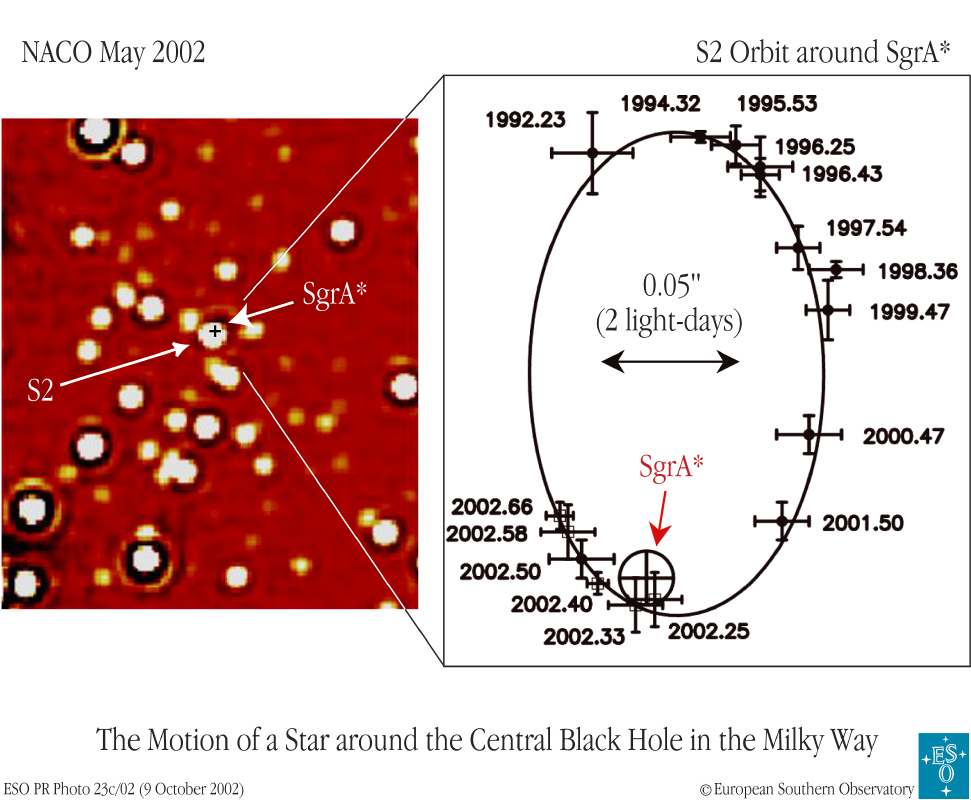
For more information see: MPE Infrared/Sub-Millimetre Group * APOD - Oct. 18, 2002 * ESO Press Release
9th October, 2002: "Quaoar" (pronounced kwah-o-wahr)
Plutos planetary position is profoundly precarious! ...
A new Kuiper Belt object has been found. It is about one-tenth the diameter of Earth, orbits the Sun once every 288 years and is only about half the size of Pluto. Michael Brown of the California Institute of Technology in Pasadena and postdoctoral scholar Chadwick Trujillo used a telescope at the Palomar Observatory near San Diego to spot the object in images taken on June 4. Follow-up observations with the Hubble Space Telescope confirmed its size. They announced their discovery at a meeting of the American Astronomical Society's Division of Planetary Sciences. The object was provisionally named Quaoar (pronounced kwah-o-whar) after a native American god.
Quaoar lies in the Kuiper Belt, a swarm of objects made of ice and rock that orbit the Sun beyond Neptune. The objects are considered fossil remnants of the swirling disk of debris that coalesced to form the solar system. It is also believed to be the source of some comets.
"This new discovery fits right in with our expectation that there should be a handful or two of objects as large as Pluto,'' said astronomer David Jewitt of the University of Hawaii.

For more information see: Caltech: Chad Trujillo * Sydney Morning Herald
26th September, 2002: Middle-Weight Contenders
In the red corner ...
It has been commonly accepted that black holes come in two different mass ranges. The stellar mass variety, occuring often in binary star systems with a (luminous) gas donor partner. As well, the million-to-billion solar mass variety that is thought to exist in the centres of many galaxies. Recent HST observations suggest a third variety!
Black holes have been found in the centres of two globular clusters, one, M15 is in our Galaxy, the other, G1, in Messier 31, the Andromeda galaxy. The team that uncovered the black hole in M15, 32,000 light-years away in the constellation Pegasus suggest the black hole's mass is 4,000 times that of our Sun. Another team found the 20,000-solar-mass black hole in G1, located 70 times farther - 2.2 million light-years away.
"These findings may be telling us something very deep about the formation of star clusters and black holes in the early universe," says Roeland Van Der Marel of the Space Telescope Science Institute in Baltimore. "Black holes are even more common in the universe than previously thought."
"The intermediate-mass black holes that have now been found with Hubble may be the building blocks of the supermassive black holes that dwell in the centers of most galaxies," says Karl Gebhardt of the University of Texas at Austin.
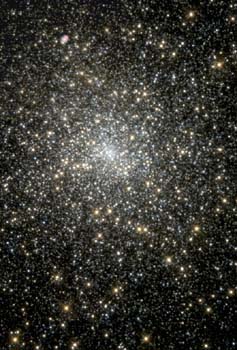
For more information see: STScI Press Release * ABC Space News
13th September, 2002: New Moon or Old Junk?
Has Earth captured a new moon? Bill Yeung, an astronomer from Arizona, found a small object on September 3. He reported his find to the Minor Planet Centre and it was categorised as a Near-Earth Object (NEO) - a piece of space debris that flies past our planet as it pursues a lonely, elliptical path around our star - and designated J002E3.
But J002E3, located about 700,000 kilometres away, or twice the distance between the Earth and Moon, turned out to be more than just your normal space debris. Further calculations determined it was not in orbit around the Sun but around the Earth, orbiting every 50 days.
"J002E3 is the first known case of an object being captured by the Earth, although Jupiter has been known to capture comets via the same mechanism," Paul Chodas of the NEO Program Office writes in JPLs NEO web site.
Experts at NASA's Jet Propulsion Laboratory (JPL) believe it could be the third-stage booster of the mighty Saturn V rocket that propelled the Apollo 12 astronauts to the Moon in November 1969. In a statement posted on the JPL NEO website, Paul Chodas suggests the spent rocket body - if indeed this is what it is - was left in "a very distant" earth orbit after it passed by the moon on November 18, 1969.

For animations see: NASA NEO J002E3 Animations
For more information see: ABC Space News * NASA Near Earth Objects - News
9th September, 2002: Way Cool! Shred away dude!
First images from the Hubble Space Telescope's latest state of the art camera, the Advanced Camera for Surveys (ACS), have captured perhaps the clearest example yet of a galaxy in the process of being literally torn apart by its bigger neighbour. Astronomers Assoc. Prof. Duncan Forbes* and Dr Mike Beasley of Swinburne University of Technology and Dr Kenji Bekki of The University of New South Wales have identified a galaxy that they believe is in the process of being `shredded' apart. The ACS image reveals the tidal plumes of stars emanating from a dwarf galaxy as it is caught in the act of being shredded.
"Although a similar disruption process is thought to be at work in our galaxy, the Milky Way, and our sister galaxy, Andromeda, this is the first time we have clear evidence of stars currently being shredded from the dwarf galaxy," Forbes said.

* Assoc. Prof. Forbes is the Semester 2, 2002 instructor for HET604 Exploring Galaxies and the Cosmos.
For more information see: Report: Centre for Astrophysics and Supercomputing * Swinburne Press Release
30th August, 2002: Pluto Occultation
A rare alignment involving the distant planet Pluto has occurred twice recently (July 20 and August 21). From our perspective Pluto moved in front of two different stars providing observers in South America and in the Pacific area a unique opportunity to study its tenuous atmosphere. In the later event the close approach (or "appulse" in astronomical terminology) of Pluto and the star P126 A was observed from various sites in South America, including the VLT.
Pluto is the only planet that has not been visited by a spacecraft. Even the Hubble Space Telescope can resolve only the largest features on its surface. Stellar occultations are presently the only way to probe Pluto's atmosphere. When the star moves behind the planet, the stellar light is refracted (i.e. bent and defocussed) by the planet's atmospheric layers. This effect causes a gradual decline of the stellar light, rather than an abrupt drop as would be the case if the planet had no atmosphere. Pluto's atmosphere was first detected on August 19, 1985, during a stellar occultation observed from Israel.
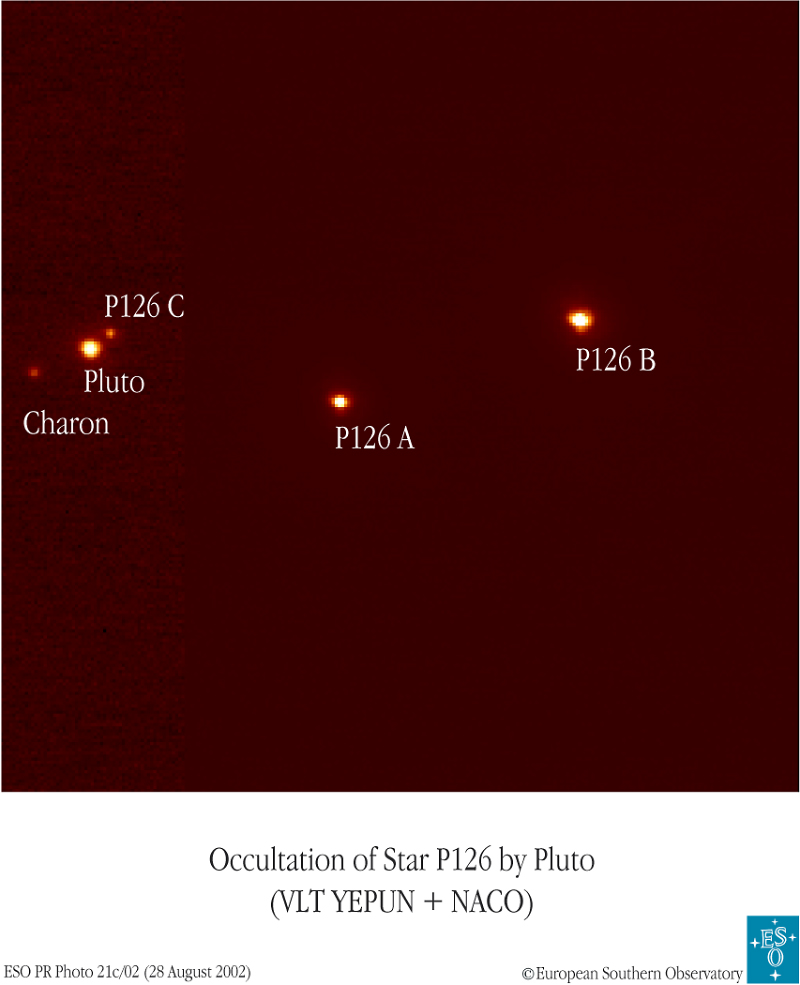
For more information see: Report from Bruno Sicardy * ESO Press Release
23rd August, 2002: Walking on the Moon (almost)
Some thirty years after humans walked on the Moon, the largest ground-based telescope, the ESO VLT has taken a dramatic snapshot of the lunar surface. The image resolution is 130 metres at the distance of the Moon.
The image was made with the NAOS-CONICA (NACO) adaptive optics camera mounted on the 8.2-m YEPUN telescope at the Paranal Observatory. The photo shows an area about 700 km from the Apollo XI landing site. The location is in the Eastern hemisphere, just North of the lunar equator, and between two of the major "seas", Mare Tranquillitatis (Sea of Tranquillity) and Mare Foecunditatis (Sea of Fertility).
The image field-of-view measures about 60 x 45 km2 including part of a sunlit, 10-km wide crater named Cameron surrounded by a comparatively level terrain, bordered by some hills and, not least, with an incredible number of smaller craters.
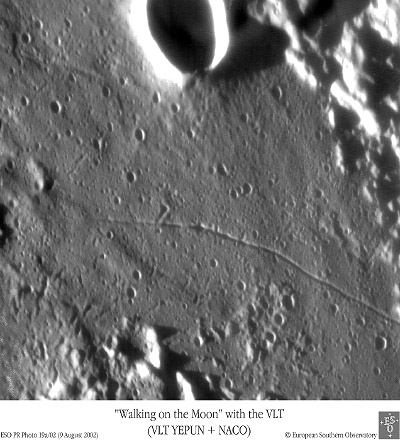
For more information see: ESO Press Release
16th August, 2002: Cen-sational!
Centaurus A, the nearest, large elliptical galaxy to us has been revealed in a new light. Scientists from the Harvard-Smithsonian Center for Astrophysics (CfA) report that two arc-like structures of multimillion-degree gas in the galaxy appear to be part of a ring 25,000 light years in diameter. The size and location of the ring suggest that it could have been produced in a titanic explosion that occurred about ten million years ago.
New data from Chandra X-ray Observatory shown in blue presents vital information about the galaxy, that is known to have undergone a merger about 100 million years ago. A broad band of dust and cold gas is bisected at an angle by opposing jets of high-energy particles blasting away from the supermassive black hole in the nucleus. Lying in a plane perpendicular to the jets are the two large arcs of X-ray emitting hot gas.
"Putting all the images together was the key to understanding what Chandra showed," said Margarita Karovska, lead author on a paper in the September 6, 2002, issue of The Astrophysical Journal.
"Suddenly it all clicked in, as with a giant puzzle, and the images fit together to make a complete picture of the galaxy geometry that was not at all apparent before."

For more information see: ABC Space News * Chandra/Harvard CfA Press Release
6th August, 2002: A Planetary Milestone
Astronomers have finally cracked the ton! To date, 101 extrasolar planets have been found, and the number is growing rapidly. At a press conference (13 June 2002) in Washington, Drs Geoff Marcy and Paul Butler, on behalf of an international collaboration of astronomers, announced the discovery of 15 new extrasolar planets detected by a variety of telescopes around the world. This took the total of extrasolar planets to 101, with 11 stars having more than one planet in orbit. Marcy and Butler noted that one planet, orbiting the star 55 Cancri in the constellation Cancer, is very "Jupiter-like", with a similar mass and orbit to our Solar System gas giant.
55 Cancri was already known to have one planet, which is a gas giant slightly smaller than Jupiter, and orbits quickly around the star in 14.6 days at a distance only one tenth the Earth-Sun distance (or Astronomical Unit, AU).
The newly found planet orbits at 5.9 AU, comparable to Jupiter's 5.2 AU distance from the Sun. With a mass between 3.5 and 5 times that of Jupiter, the planet has a slightly elongated orbit that carries it around the star in about 13 years, comparable to Jupiter's orbital period of 11.86 years.
The team also reported a third planet around 55 Cancri, a gas giant with an orbital radius of 0.24 AU and a mass of about 0.21 Jupiter masses. That planet orbits in 44 days.
One of the team, Dr Chris Tinney of the Anglo-Australian Observatory described a new planet detected around the star, HD 76700. It is the second smallest yet discovered: about one-fifth the mass of Jupiter and it is in a nearly circular orbit, similar in size to the orbit of Mercury.
"The exciting thing about it is that this is such a small planet, and if we can detect this, it makes us more confident of finding more solar systems more like ours," Dr Chris Tinney told ABC Science Online. "The closer the planet to the star, the easier it is for us to detect it," said Dr Tinney. "If we can see something only 20 per cent the size of Jupiter close-in, we may be able to spot a Jupiter-like planet out where Jupiter is in our solar system."
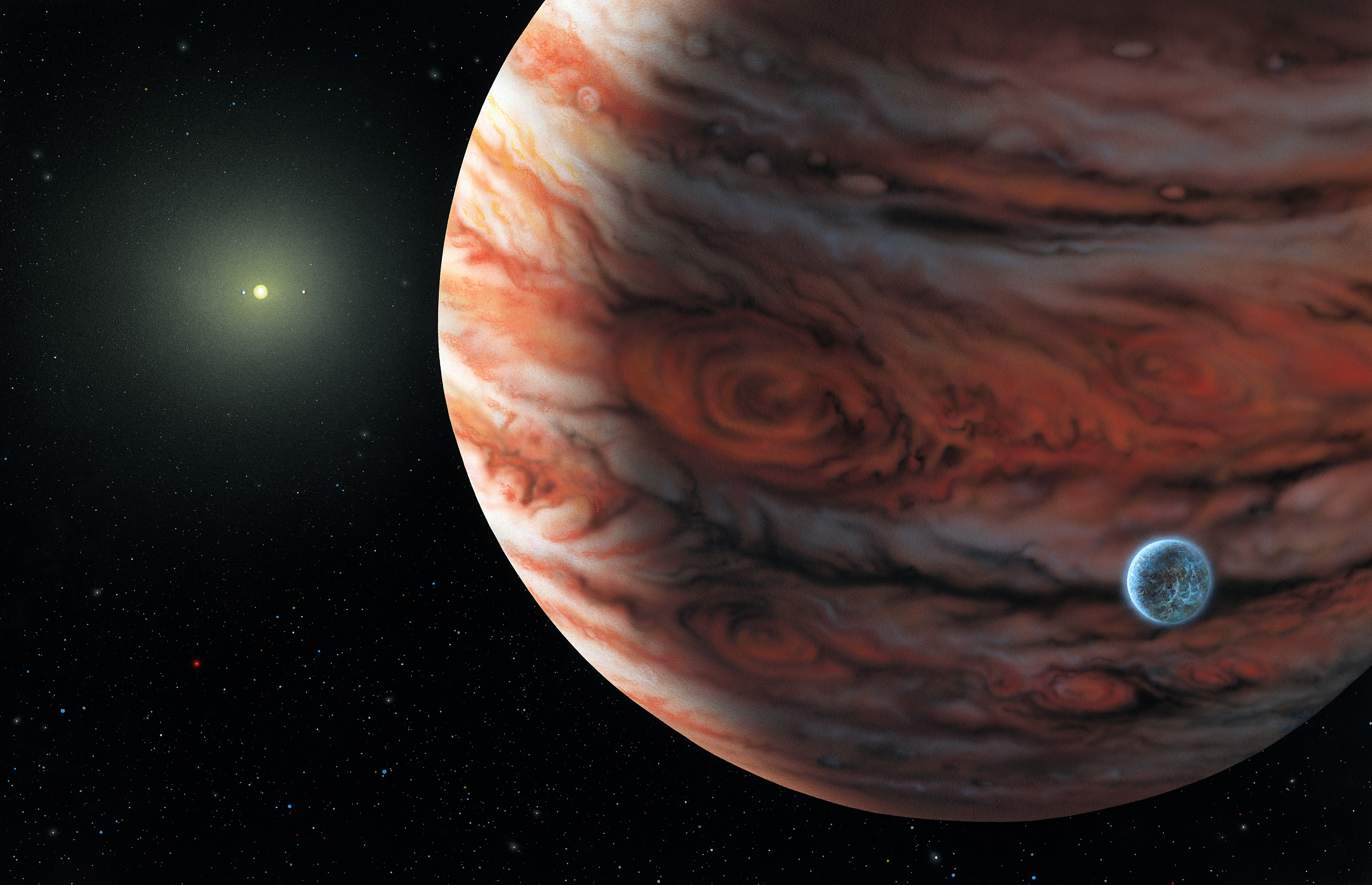
For more information see: ABC Space News * U. California-Berkeley Press Release * Extrasolar Planets Encyclopaedia






